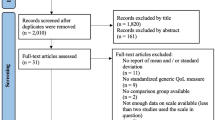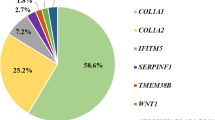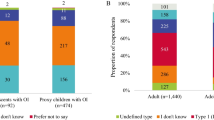Abstract
The objective of this study was to evaluate and compare the psychometric properties of the EQ-5D-Y-3L, EQ-5D-Y-5L, CHU-9D, and PedsQL, in a sample of children and adolescents with osteogenesis imperfecta (OI). A web-based cross-sectional survey was conducted among Chinese children and adolescents with OI in 2021. The EQ-5D-Y-3L, EQ-5D-Y-5L, CHU-9D, and PedsQL were used to assess the health-related quality of life for the participants. Construct validity, including convergent and divergent validity, known-group validity, and test–retest reliability, was examined to assess the psychometric properties of the measures. A total of 157 pediatric OI patients self-completed the questionnaire. Few of them reported the full health status. A strong ceiling effect was observed for all dimensions on the EQ-5D-Y and most on CHU-9D. Most dimensions of the EQ-5D-Y and CHU-9D showed statistically significant correlations with the hypothesized PedsQL subscales. The test–retest reliability for the EQ-5D-Y-3L, EQ-5D-Y-5L, and CHU-9D was acceptable. The EQ-5D-Y-5L showed a better known-group validity than EQ-5D-Y-3L, CHU-9D, and PedsQL in differentiating patients in risk groups.
Conclusion: The results confirmed that the EQ-5D-Y and CHU-9D are reliable and valid in pediatric OI patients. The EQ-5D-Y-5L performed better than EQ-5D-Y-3L regarding acceptability, convergent validity, and discriminatory power.
What is Known: • Performance of the preference-based measures has never been reported in patients with Osteogenesis imperfecta. | |
What is New: • The EQ-5D-Y demonstrated higher sensitivity and discriminatory power than the CHU-9D in patients with osteogenesis Imperfecta • The EQ-5D-Y-3L performed slightly better than EQ-5D-Y-5L regarding convergent validity and discriminant ability |
Similar content being viewed by others
Availability of data and material
The datasets generated during and/or analyzed during the current study are available from the corresponding author on reasonable request.
Code availability
Not applicable.
Abbreviations
- CHU-9D:
-
Child Health Utility 9D
- EQ-5D-Y:
-
EuroQol five-dimension instrument for youth
- ICC:
-
Intraclass correlation coefficient
- HRQoL:
-
Health-related quality of life
- OI:
-
Osteogenesis imperfecta
- PedsQL:
-
Pediatric Quality of Life Inventory
References
Byers P (2012) Recessively inherited forms of osteogenesis imperfecta. Annu Rev Genet 46:475–497. https://doi.org/10.1146/annurev-genet-110711-155608
Lim G, Alexander L (2017) Genetic causes and mechanisms of osteogenesis imperfecta. Bone 102:40–49. https://doi.org/10.1016/j.bone.2017.02.004
China OI Foundation (2013) Annual Report of OI in China
Vanz AP, van de Sande Lee J, Pinheiro B, Zambrano M, Brizola E, da Rocha NS, Schwartz IV, de Souza Pires MM, Félix TM (2018) Health-related quality of life of children and adolescents with osteogenesis imperfecta: a cross-sectional study using PedsQLTM. BMC Pediatr 18:1–6. https://doi.org/10.1186/s12887-018-1077-z
Song Y, Zhao D, Li L, Lv F, Wang O, Jiang Y, Xia W, Xing X, Li M (2019) Health-related quality of life in children with osteogenesis imperfecta: a large-sample study. Osteoporos Int 30:461–8. https://doi.org/10.1007/s00198-018-4801-5
Dahan-Oliel O, Tsimicalis M, Rauch D (2016) Quality of life in osteogenesis imperfecta: a mixed-methods systematic review. Am J Med Genet 170A:62–76. https://doi.org/10.1002/ajmg.a.37377
Matza LS, Swensen AR, Flood EM, Secnik K, Leidy NK (2004) Assessment of health-related quality of life in children: a review of conceptual, methodological, and regulatory issues. Value Heal 7:79–92. https://doi.org/10.1111/j.1524-4733.2004.71273.x
Kind P, Klose K, Gusi N, Olivares PR, Greiner W (2015) Can adult weights be used to value child health states? Testing the influence of perspective in valuing EQ-5D-Y.(Report). Qual Life Res 24:2519. https://doi.org/10.1007/s11136-015-0971-1
Wille N, Badia X, Bonsel G, Burström K, Cavrini G, Devlin N, Egmar AC, Greiner W, Gusi N, Herdman M, Jelsma J et al (2010) Development of the EQ-5D-Y: a child-friendly version of the EQ-5D. (Report). Qual Life Res 19:875. https://doi.org/10.1007/s11136-010-9648-y
Kreimeier G (2019) EQ-5D-Y as a health-related quality of life instrument for children and adolescents: the instrument’s characteristics, development, current use, and challenges of developing its value set. Value Heal 22:31–37. https://doi.org/10.1016/j.jval.2018.11.001
Bergfors Å, Burström E (2015) Measuring health-related quality of life with the EQ-5D-Y instrument in children and adolescents with asthma. Acta Paediatr 104:167–173. https://doi.org/10.1111/apa.12863
Ravens-Sieberer U, Wille N, Badia X, Bonsel G, Burström K, Cavrini G, Devlin N, Egmar AC, Gusi N, Herdman M, Jelsma J et al (2010) Feasibility, reliability, and validity of the EQ-5D-Y: results from a multinational study. An Int J Qual Life Asp Treat Care Rehabil - Off J Int Soc Qual Life Res 19:887–97. https://doi.org/10.1007/s11136-010-9649-x
Åström M, Persson C, Lindén-Boström M, Rolfson O, Burström K (2018) Population health status based on the EQ-5D-Y-3L among adolescents in Sweden: results by sociodemographic factors and self-reported comorbidity. An Int J Qual Life Asp Treat Care Rehabil - An Off J Int Soc Qual Life Res 27:2859–71. https://doi.org/10.1007/s11136-018-1985-2
Kreimeier Å, Burström E, Gusi H, Kind P-S, Greiner, (2019) EQ-5D-Y-5L: developing a revised EQ-5D-Y with increased response categories. Qual Life Res 28:1951–1961. https://doi.org/10.1007/s11136-019-02115-x
Stevens K (2009) Developing a descriptive system for a new preference-based measure of health-related quality of life for children. Qual Life Res 18:1105–13. https://doi.org/10.1007/s11136-009-9524-9
Stevens R (2012) Measuring and valuing health benefits for economic evaluation in adolescence: an assessment of the practicality and validity of the Child Health Utility 9D in the Australian adolescent population. VALUE Heal 15:1092–1099. https://doi.org/10.1016/j.jval.2012.07.011
Peasgood T, Bhardwaj A, Biggs K, Brazier JE, Coghill D, Cooper CL, Daley D, De Silva C, Harpin V, Hodgkins P et al (2016) The impact of ADHD on the health and well-being of ADHD children and their siblings. Eur Child Adolesc Psychiatry 25:1217–31. https://doi.org/10.1007/s00787-016-0841-6
Ryan JM, McKay E, Anokye N, Noorkoiv M, Theis N, Lavelle G (2020) Comparison of the CHU-9D and the EQ-5D-Y instruments in children and young people with cerebral palsy: a cross-sectional study. BMJ Open 10. https://doi.org/10.1136/bmjopen-2020-037089
Foster Page LA, Beckett DM, Cameron CM, Thomson WM (2015) Can the Child Health Utility 9D measure be useful in oral health research? Int J Paediatr Dent 25:349–57. https://doi.org/10.1111/ipd.12177
Herdman G, Lloyd J, Kind P, Bonsel B (2011) Development and preliminary testing of the new five-level version of EQ-5D (EQ-5D-5L). Qual Life Res 20:1727–1736. https://doi.org/10.1007/s11136-011-9903-x
EuroQol Research Foundation (2020) EQ-5D-Y User Guide How to apply, score, and present results from the EQ-5D-Y Version. Euroqol.Org 1–38. https://euroqol.org/publications/user-guides. Accessed 9 Aug 2022
Shiroiwa T, Ikeda S, Noto S, Fukuda T, Stolk E (2021) Valuation survey of EQ-5D-Y based on the International Common Protocol: development of a value set in Japan. Med Decis Mak 41:597–606. https://doi.org/10.1177/0272989X211001859
Geraerds AJ, Bonsel GJ, Janssen MF, de Jongh MA, Spronk I, Polinder S, Haagsma JA (2019) The added value of the EQ-5D with a cognition dimension in injury patients with and without traumatic brain injury. Qual Life Res 28:1931–9. https://doi.org/10.1007/s11136-019-02144-6
Stevens KJ (2010) Working with children to develop dimensions for a preference-based, generic, pediatric, health-related quality-of-life measure. Qual Health Res 20:340–51. https://doi.org/10.1177/1049732309358328
Yang P, Chen G, Wang P, Zhang K, Deng F, Yang H, Zhuang G Psychometric evaluation of the Chinese version of the Child Health Utility 9D (CHU9D-CHN): a school-based study in China. An Int J Qual Life Asp Treat Care Rehabil - An Off J Int Soc Qual Life Res 2018;27:1921–31. https://doi.org/10.1007/s11136-018-1864-x
Chen Xu, Huynh W, Stevens R (2019) Scoring the Child Health Utility 9D instrument: estimation of a Chinese child and adolescent-specific tariff. Qual life Res an Int J Qual life Asp Treat care Rehabil 28:163–176. https://doi.org/10.1007/s11136-018-2032-z
Varni JW, Seid M, Kurtin PS (2001) PedsQL 4.0: reliability and validity of the Pediatric Quality of Life Inventory version 4.0 generic core scales in healthy and patient populations. Med Care 39:800
DeVellis RF (2017) Scale development : theory and applications. Fourth Edi. Los Angeles : SAGE
Watson P (2010) Method agreement analysis: a review of correct methodology. Theriogenology 73:1167–1179. https://doi.org/10.1016/j.theriogenology.2010.01.003
Wongpakaran N, Wongpakaran T, Wedding D, Gwet KL (2013) A comparison of Cohen’s kappa and Gwet’s AC1 when calculating inter-rater reliability coefficients: a study conducted with personality disorder samples. BMC Med Res Methodol 13. https://doi.org/10.1186/1471-2288-13-61
Landis K (1977) The measurement of observer agreement for categorical data. Biometrics 33:159. https://doi.org/10.2307/2529310
Terwee CB, Bot SD, de Boer MR, van der Windt DA, Knol DL, Dekker J, Bouter LM, de Vet HC (2007) Quality criteria were proposed for measurement properties of health status questionnaires. J Clin Epidemiol 60:34–42. https://doi.org/10.1016/j.jclinepi.2006.03.012
Zhou W, Shen A, Yang Z, Wang P, Wu B, Herdman M, Luo N (2021) Patient-caregiver agreement and test–retest reliability of the EQ-5D-Y-3L and EQ-5D-Y-5L in paediatric patients with haematological malignancies. Eur J Heal Econ 22:1103–13. https://doi.org/10.1007/s10198-021-01309-w
Fitriana TS, Purba FD, Rahmatika R, Muhaimin R, Sari NM, Bonsel G, Stolk E, Busschbach JJ (2021) Comparing measurement properties of EQ-5D-Y-3L and EQ-5D-Y-5L in paediatric patients. Health Qual Life Outcomes 19:256. https://doi.org/10.1186/s12955-021-01889-4
Wong C, Luo C (2019) A head-to-head comparison of five-level (EQ-5D-5L-Y) and three-level EQ-5D-Y questionnaires in paediatric patients. Eur J Heal Econ 20:647–656. https://doi.org/10.1007/s10198-018-1026-7
Verstraete J, Amien R, Scott D (2022) Comparing measurement properties of the English EQ-5D-Y 3-level version with the 5-level version in South Africa. Value Heal Reg Issues 30:140–7. https://doi.org/10.1016/j.vhri.2021.12.004
Shiroiwa T, Fukuda T, Shimozuma K (2019) Psychometric properties of the Japanese version of the EQ-5D-Y by self-report and proxy-report: reliability and construct validity. Qual Life Res 28:3093–105. https://doi.org/10.1007/s11136-019-02238-1
Verstraete S (2022) Comparison of the EQ-5D-Y-5L, EQ-5D-Y-3L and PedsQL in children and adolescents. J Patient-Reported Outcomes 6:67. https://doi.org/10.1186/s41687-022-00480-9
Verstraete J, Marthinus Z, Dix-Peek S, Scott D (2022) Measurement properties and responsiveness of the EQ-5D-Y-5L compared to the EQ-5D-Y-3L in children and adolescents receiving acute orthopaedic care. Health Qual Life Outcomes 20:28. https://doi.org/10.1186/s12955-022-01938-6
Arponen H, Waltimo-Sirén J, Valta H, Mäkitie O (2018) Fatigue and disturbances of sleep in patients with osteogenesis imperfecta - a cross-sectional questionnaire study. BMC Musculoskelet Disord 19:3. https://doi.org/10.1186/s12891-017-1922-5
Davis E, Waters E, Mackinnon A, Reddihough D, Graham HK, Mehmet-Radji O, Boyd R (2006) Paediatric quality of life instruments: a review of the impact of the conceptual framework on outcomes. Dev Med Child Neurol 48:311–8. https://doi.org/10.1017/S0012162206000673
Pan CW, Zhong H, Li J, Suo C, Wang P (2020) Measuring health-related quality of life in elementary and secondary school students using the Chinese version of the EQ-5D-Y in rural China. BMC Public Health 20:982. https://doi.org/10.1186/s12889-020-09116-3
Zanganeh M, Adab P, Li B, Frew E (2021) An assessment of the construct validity of the Child Health Utility 9D-CHN instrument in school-aged children: evidence from a Chinese trial. Health Qual Life Outcomes 19:205. https://doi.org/10.1186/s12955-021-01840-7
Forestier-Zhang L, Watts L, Turner A, Teare H, Kaye J, Barrett J, Cooper C, Eastell R, Wordsworth P, Javaid MK et al (2016) Health-related quality of life and a cost-utility simulation of adults in the UK with osteogenesis imperfecta, X-linked hypophosphatemia and fibrous dysplasia. Orphanet J Rare Dis 11. https://doi.org/10.1186/s13023-016-0538-4
Hsu L, Pickard T (2018) EQ-5D-Y for the assessment of health-related quality of life among Taiwanese youth with mild-to-moderate chronic kidney disease. Int J Qual Heal care J Int Soc Qual Heal Care 30:298–305. https://doi.org/10.1093/intqhc/mzy011
Devlin N, Pan T, Kreimeier S, Verstraete J, Stolk E, Rand K, Herdman M (2022) Valuing EQ-5D-Y: the current state of play. Health Qual Life Outcomes 20:105. https://doi.org/10.1186/s12955-022-01998-8
Funding
This work was supported by the EuroQol Research Foundation (85-2020RA).
Author information
Authors and Affiliations
Contributions
All authors contributed to the study conception and design. Material preparation, data collection, and analysis were performed by RHX, NL, SNZ, and DD. The first draft of the manuscript was written by RHX, and all authors commented on previous versions of the manuscript. All authors read and approved the final manuscript.
Corresponding authors
Ethics declarations
Ethics approval
This study was performed in line with the principles of the Declaration of Helsinki. The study proposal and informed consent were approved by the Survey and Behavioural Research Ethics Committee of the Chinese University of Hong Kong (Ref ID: SBRE-19–793).
Consent to participate
Written informed consent was obtained from the participants.
Consent for publication
Not applicable.
Conflict of interest
The authors declare no competing interests.
Additional information
Communicated by Gregorio Paolo Milani
Publisher's Note
Springer Nature remains neutral with regard to jurisdictional claims in published maps and institutional affiliations.
Supplementary Information
Below is the link to the electronic supplementary material.
Rights and permissions
Springer Nature or its licensor holds exclusive rights to this article under a publishing agreement with the author(s) or other rightsholder(s); author self-archiving of the accepted manuscript version of this article is solely governed by the terms of such publishing agreement and applicable law.
About this article
Cite this article
Xu, R.H., Zhu, L., Sun, R. et al. Investigating the psychometric properties of the EQ-5D-Y-3L, EQ-5D-Y-5L, CHU-9D, and PedsQL in children and adolescents with osteogenesis imperfecta. Eur J Pediatr 181, 4049–4058 (2022). https://doi.org/10.1007/s00431-022-04626-1
Received:
Revised:
Accepted:
Published:
Issue Date:
DOI: https://doi.org/10.1007/s00431-022-04626-1




